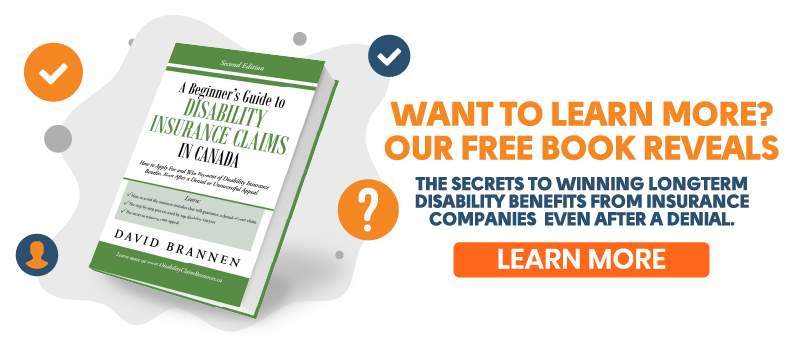Are you looking to apply for long-term disability (LTD) in Ontario? Have you been searching for a step-by-step guide? If so, you have stumbled upon the right article. In this post, we overview a simple (but complete) 7-step process to complete your application for long-term disability in Ontario.
This article is part of our Definitive Guide to Long-Term Disability Ontario.
Step 1: Figure out when the waiting period ends
Every LTD insurance plan has something called a “waiting period.” In essence, this term means you can only qualify for long-term disability benefits if you are off work for a specified period of time.
Waiting periods vary from policy to policy. They can range between 12 to 52 weeks. However, most plans have a waiting period that falls within the 17 to the 22-week range. If you are insured under a private or individual plan, check your policy to see what your waiting period is. And if you are insured under a group policy, check your group benefits booklet.
Although we don’t recommend submitting your application months and months before the waiting period ends, we encourage you to start your application at least four weeks in advance. This is because benefits administrators need time to process your application. Oftentimes it takes them four weeks or more. Additionally, it may take you a few weeks to finish your application. You aren’t the only one who needs to fill it out. You will have to get your doctor to fill out the medical form and your employer to complete out the employer form. Organizing all this can take some time. So, give yourself a head-start by getting everything in order before the waiting period ends.
Step 2: Make sure your doctor supports you in applying for long-term disability in Ontario
The next thing you will want to do is ensure that your doctor supports you in applying for long-term disability. You should make sure of this before you start your application. Unfortunately, you will never get approved for LTD if your doctor isn’t on your side.
It is crucial to have a clear conversation with your doctor. You need to be absolutely sure they will recommend that you stay off work after the waiting period ends.
If you do have this conversation, and they agree you need to go on long-term disability, you are good to start your application. However, if they don’t support you or recommend that you try and go back to work, you will need to delay your application until you get their support or figure out another plan.
Step 3: Tell the insurance company you want to apply for long-term disability
Now that you have your doctor’s support, the next thing you can do is let your insurer know you want to apply for long-term disability. Application steps will differ from plan to plan. So, you need to ask them what steps you will need to take.
Usually, however, there are two options.
The first is you may not need to do anything else. If the insurance company is already paying your short-term disability, then they may consider your LTD claim automatically. Or, they may only need an updated medical report from your doctor.
The other possibility is the insurance company may ask you to fill out an application for LTD. This situation is more common when the insurer has not managed your short-term disability claim. If this is the case, they will send you an application package, which usually includes an application form, a medical form, and an employer form.
Step 4: Fill out the forms in the application package
If the insurance company asks you to fill out an application, it will usually include three forms:
- Application form (you fill out)
- Medical form (your doctor fills out)
- Employers form (your employer fills out)
Application form
You are responsible for filling out the application form. Many of the questions may seem simple but take your time, as questions about your work, medical conditions, symptoms, and limitations will require special care. If you run out of space on the form, it’s perfectly acceptable to write in the margins. You can even attach a separate sheet of information — but make sure you indicate that you have done this.
It is crucial to get the application submitted as soon as possible. All insurance plans have a deadline. It is usually 3 to 6 months after the end of your waiting period. We recommend you get your application in before your waiting period ends. However, if you have missed the deadline to apply, reach out to us or another law firm to learn what you should do.
Doctor’s form
In our experience, the doctor’s form is the most essential part of your application for LTD in Ontario. The insurance company cares most about how your doctor describes your medical condition, limitations, and treatment plan. While you can give this information to the insurance company yourself, they will not take it seriously unless it comes from your doctor.
It is your responsibility to get the doctor to fill out this form. We recommend you make an appointment with your doctor, where you exclusively deal with this form. That way, the doctor knows it is coming. Do not try to fit it in during another appointment. And do not drop it off for the doctor to fill out in their spare time. It is best to have the entire appointment time devoted to the form so the doctor can ask you questions while filling out the form.
Employer’s form
You have to arrange for your employer to fill out the employer’s form. This form asks them to confirm your job title, salary, hours of work, job duties, and responsibilities. Ideally, you will want to review this form before it gets sent to the insurer. You want to do this to ensure the information on it is accurate. Some employers will provide incorrect information either by mistake or on purpose.
If you notice incorrect information on the employer’s form, do not write on it or edit it in anyway. It is critical that the employer’s form is written by your employer, not you. Otherwise, it may look like you are tampering with the form. If you see incorrect information, start by bringing this up with the employer. It may have been an oversight or mistake. They can correct it on a new form. However, if the employer refuses to correct the information, you can address this in a separate letter attached to your application. Regardless of this situation, do not write anything on the employer form.
Step 5: Submit the application and supporting documents
In an ideal world, you want to submit your application in one package with all the supporting documents attached. This would include the following:
- Your application form, completed and signed
- A sheet attached to the application form with any additional information that would not fit on the form
- A completed and signed medical form
- Employers form, completed and signed
- Cover letter
However, not everyone has this option. And you may not be able to send everything at once. For instance, some doctors and employers will want to send the forms directly to the insurance company. Other times, it may take your employer or doctor a long time to complete the form. If this is the case, you should still submit what you have as soon as possible. That way, you can get a head-start on the application process. Additionally, if you’re waiting for one person to complete a form, sometimes the claim representative will speak to them. This can help speed up the process.
Step 6: Be cooperative with reasonable requests from the insurer when applying for long-term disability in Ontario
This is a step that many people overlook. However, it is a vital aspect of applying and ultimately getting approved for LTD.
When applying for long-term disability in Ontario, your claim representative may ask you to do a few things. The following are some common requests:
- Speak with them by phone to answer questions
- Provide copies of your medical records
- Ask your doctor to give you more information
If you are asked to do any of these things, you should act in good faith and get them anything they need — so long as the request is reasonable.
By reasonable requests, I don’t mean what you personally feel is reasonable or what your doctor thinks is reasonable. Rather, I am referring to what a court would determine as reasonable in the circumstances. You need to follow this standard when deciding whether to deny a request from the insurance company.
Many individuals have an impulse to provide as little information as possible or to deny requests for more information or documents. We have seen people succumb to this urge multiple times.
Please resist the instinct to do this. If you act unreasonably, it hurts your credibility and ultimately makes it harder for them to approve your claim. Many people don’t realize just how important credibility is when it comes to disability claims. When people view you as credible, you have a way better chance of getting approved. On the other hand, if you are not viewed as credible, you are much less likely to get approved — even if you are legitimately disabled.
The other thing you should consider is if your claim is denied, you will likely have to prove your case in court. You want the judge or decision maker to see that you acted reasonably. If the judge concludes you were being unreasonable or purposefully difficult, then you have a small chance of winning your case.
Step 7: Wait
The last and often hardest step in applying for long-term disability in Ontario is to wait for the insurance company to make a decision.
If your application is complete, it usually takes 30 to 60 days to get a final decision. However, it may take longer if you are waiting on a form from your doctor or employer. Or if you get delayed in completing the reasonable requests from the insurer.
In most cases, you will receive the decision in an email or letter. However, sometimes a representative may tell you over the phone.
Approved
If the insurer approves your application, make sure you read the letter carefully. In some cases, approvals are conditional or temporary. You might need to get them other outstanding information by a deadline.
Denied
If the insurance company denies your application, you have the right to ask them to reconsider. This is called an internal appeal.
However, we strongly recommend that you consult with us at Resolute Legal or another reputable disability firm before you submit your appeal. Each appeal needs to be done strategically in order to maximize your chances of success. The right approach for you will be different from what others should do. This is because no two situations are the same.
Free Book



